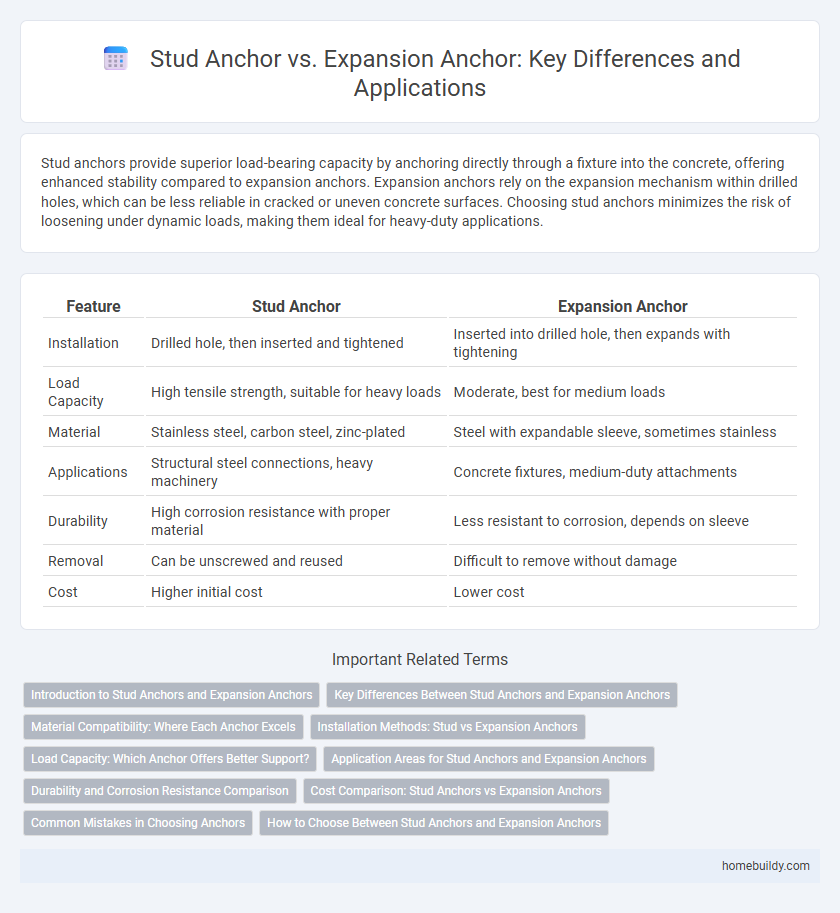Stud anchors provide superior load-bearing capacity by anchoring directly through a fixture into the concrete, offering enhanced stability compared to expansion anchors. Expansion anchors rely on the expansion mechanism within drilled holes, which can be less reliable in cracked or uneven concrete surfaces. Choosing stud anchors minimizes the risk of loosening under dynamic loads, making them ideal for heavy-duty applications.
Table of Comparison
| Feature | Stud Anchor | Expansion Anchor |
|---|---|---|
| Installation | Drilled hole, then inserted and tightened | Inserted into drilled hole, then expands with tightening |
| Load Capacity | High tensile strength, suitable for heavy loads | Moderate, best for medium loads |
| Material | Stainless steel, carbon steel, zinc-plated | Steel with expandable sleeve, sometimes stainless |
| Applications | Structural steel connections, heavy machinery | Concrete fixtures, medium-duty attachments |
| Durability | High corrosion resistance with proper material | Less resistant to corrosion, depends on sleeve |
| Removal | Can be unscrewed and reused | Difficult to remove without damage |
| Cost | Higher initial cost | Lower cost |
Introduction to Stud Anchors and Expansion Anchors
Stud anchors consist of a threaded bolt embedded into a base material, providing high load-bearing capacity and reliability for structural connections. Expansion anchors work by expanding against the sides of a drilled hole when tightened, creating friction to resist pullout forces in concrete or masonry. Compared to expansion anchors, stud anchors offer superior strength and durability for heavy-duty construction applications requiring precise alignment and long-term stability.
Key Differences Between Stud Anchors and Expansion Anchors
Stud anchors provide superior load capacity and are ideal for heavy-duty applications in concrete and masonry, offering direct embedment through drilled holes. Expansion anchors rely on mechanical forces created by expansion against the hole walls, making them suitable for lighter loads and easier installation in various base materials. Key differences include load performance, installation method, and suitability for specific substrates, with stud anchors favoring structural use and expansion anchors used in non-structural applications.
Material Compatibility: Where Each Anchor Excels
Stud anchors excel in material compatibility with concrete and masonry due to their embedded design that provides superior load distribution and resistance to pull-out forces. Expansion anchors perform best in solid base materials like concrete and natural stone, where their mechanical expansion creates a strong grip by exerting radial pressure within the drilled hole. Both anchors require careful selection based on substrate type, with stud anchors ideal for heavy-duty applications in reinforced concrete and expansion anchors suited for lighter loads in solid masonry.
Installation Methods: Stud vs Expansion Anchors
Stud anchors require drilling a precise hole followed by insertion and mechanical or chemical setting to create a secure bond, ensuring high load capacity and minimal movement under stress. Expansion anchors rely on the expansion mechanism that grips the substrate as the anchor is driven or screwed in, offering easier installation but potentially less holding power in weaker materials. The choice depends on the substrate type and load requirements, with stud anchors favored for heavy-duty, reliable fastening in solid concrete, while expansion anchors are suitable for lighter loads and faster setup.
Load Capacity: Which Anchor Offers Better Support?
Stud anchors provide superior load capacity compared to expansion anchors due to their design, which allows for direct bearing on the base material rather than relying on friction alone. Load capacities for stud anchors can reach up to 60 kN in concrete, making them ideal for heavy-duty applications requiring maximum support. Expansion anchors typically offer lower load ratings, limited by the concrete's surface condition and expansion force, which can range between 10 to 40 kN depending on size and installation quality.
Application Areas for Stud Anchors and Expansion Anchors
Stud anchors excel in applications requiring high pull-out strength and vibration resistance, commonly used in construction for securing heavy machinery and structural supports. Expansion anchors are ideal for lighter loads and non-critical fixings, often employed in drywall installations and fastening fixtures in masonry. The choice depends on load capacity demands, substrate type, and environmental conditions.
Durability and Corrosion Resistance Comparison
Stud anchors exhibit superior durability compared to expansion anchors due to their robust design and the ability to distribute loads more evenly within the base material. Made from high-grade stainless steel or galvanized steel, stud anchors provide enhanced corrosion resistance, making them ideal for harsh environments and outdoor applications. Expansion anchors, often composed of lower-grade metals, tend to suffer from corrosion over time, reducing their structural integrity and lifespan.
Cost Comparison: Stud Anchors vs Expansion Anchors
Stud anchors typically offer a more cost-effective solution compared to expansion anchors due to lower installation labor and equipment requirements. Expansion anchors often incur higher expenses linked to precise drilling and potential need for specialized tools, increasing overall project costs. Choosing stud anchors can reduce total anchor system costs while maintaining reliable load-bearing performance in various construction applications.
Common Mistakes in Choosing Anchors
Choosing between a stud anchor and an expansion anchor often leads to common mistakes such as selecting an expansion anchor for heavy-duty applications that require the superior load-bearing capacity of a stud anchor. Many fail to consider the specific base material, where stud anchors provide better performance in concrete compared to expansion anchors that may loosen in softer substrates. Misunderstanding these technical distinctions can result in inadequate anchoring strength and compromised structural integrity.
How to Choose Between Stud Anchors and Expansion Anchors
Choosing between stud anchors and expansion anchors depends on load requirements and base material type. Stud anchors provide superior tensile strength and are ideal for heavy-duty applications in concrete and steel, while expansion anchors offer easier installation and are best for lighter loads in solid base materials such as concrete and brick. Assessing environmental conditions, load direction, and safety factors ensures optimal anchor performance and structural integrity.
Stud anchor vs expansion anchor Infographic

 homebuildy.com
homebuildy.com